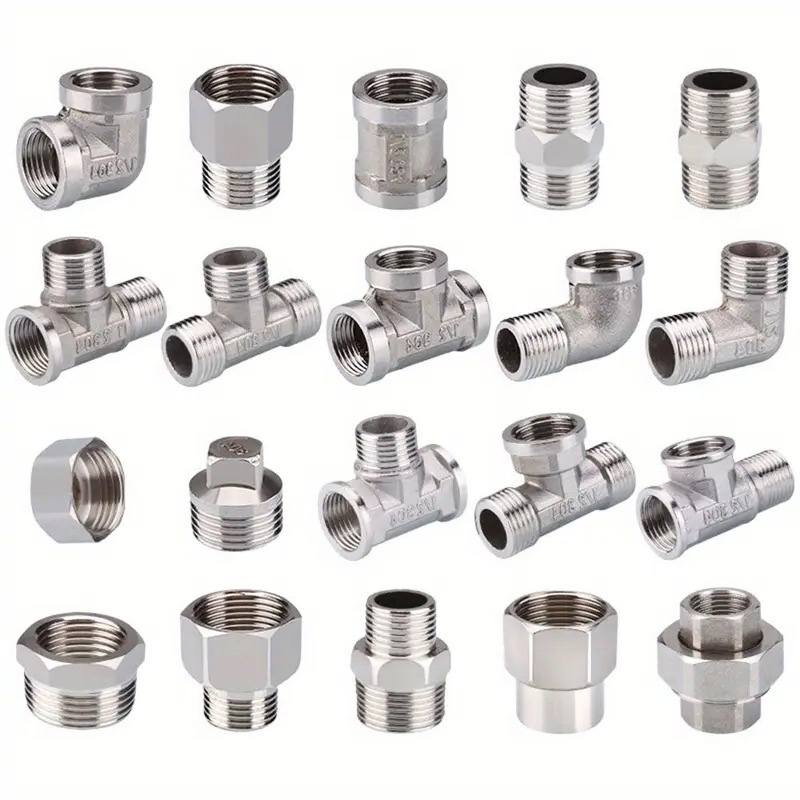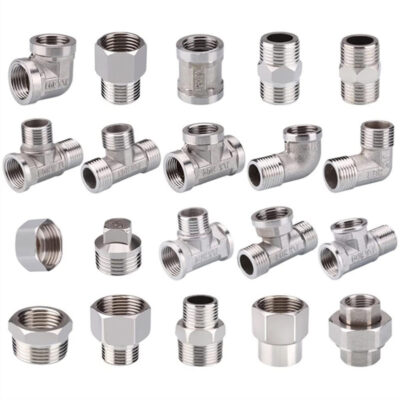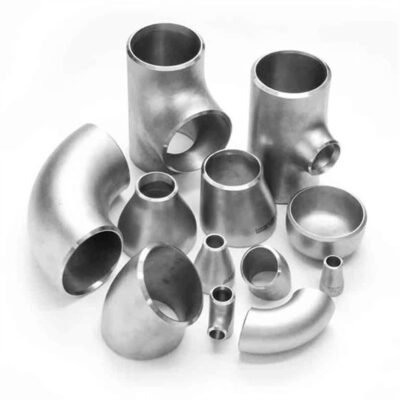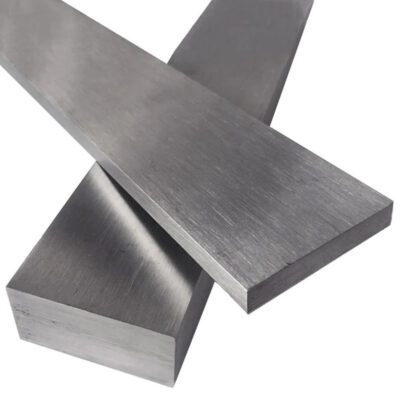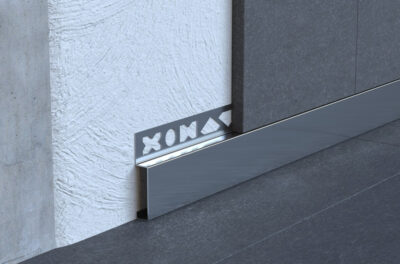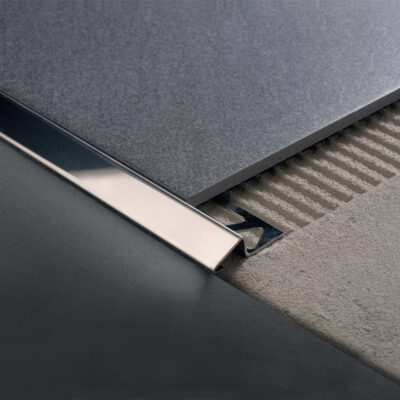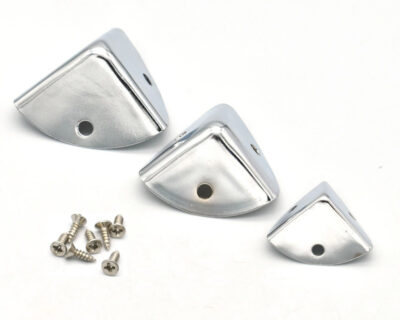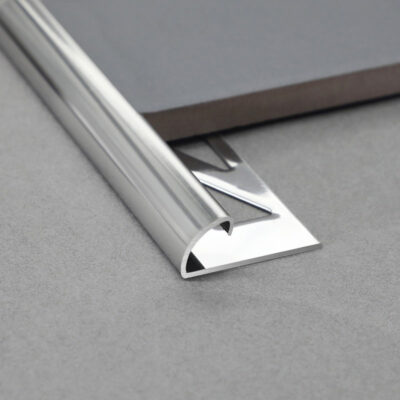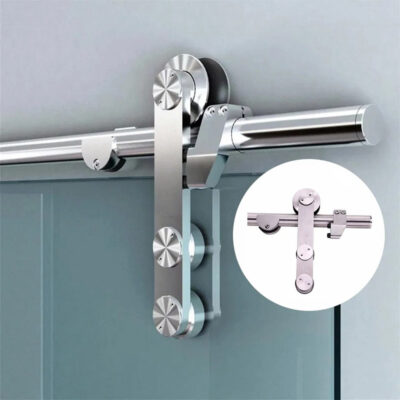Understanding Stainless Steel Pipe Fittings
The world of industrial piping systems wouldn’t function without critical components that connect straight pipe sections and change flow direction. During my years consulting on fluid transport systems, I’ve repeatedly seen how stainless steel elbows and tees form the backbone of reliable piping networks across numerous industries. These seemingly simple components carry tremendous responsibility in maintaining system integrity.
Stainless steel ittings earn their reputation through a combination of mechanical strength and corrosion resistance that few other materials can match. When I visited a seaside chemical processing facility last year, the maintenance supervisor pointed out 25-year-old stainless fittings that remained in near-perfect condition despite constant exposure to salt air and aggressive chemicals. This durability stems from the chromium content (minimum 10.5%) that forms a self-healing protective oxide layer when exposed to oxygen.
The terminology around these components can sometimes confuse newcomers to the field. Elbows change the direction of flow, typically at angles of 45° or 90°, while tees create branch connections from a main line, allowing flow distribution to multiple pathways. Both come in various configurations, including different end connections (threaded, socket-weld, butt-weld), schedule thicknesses, and manufacturing methods (cast, forged, or machined).
What’s particularly interesting about stainless steel fittings is their diversity across applications. The same basic design principles apply whether you’re looking at miniature fittings in semiconductor manufacturing or massive components in petrochemical refineries. The fundamental difference lies in material grade selection, wall thickness, and manufacturing precision.
Types and Specifications of Stainless Steel Elbows
Stainless steel elbows come in several configurations, each designed for specific requirements. The most common differentiation comes from the angle of direction change, with 90° and 45° being standard, though 180° (return bends), 60°, and custom angles exist for specialized applications.
Beyond angles, we must consider the elbow’s radius. Short-radius elbows (1D – where D equals the pipe diameter) create tighter turns but increase pressure drop and potential erosion. Long-radius elbows (1.5D) provide smoother flow transitions, reducing turbulence. During a refinery upgrade project I worked on, we specifically switched from short to long-radius elbows in high-flow sections after computational fluid dynamics modeling showed significant efficiency improvements.
Manufacturing methods significantly impact performance characteristics:
Seamless elbows are formed from solid pipe through processes like hot pushing or cold drawing. These eliminate the weld line entirely, providing maximum pressure integrity. Dr. Hiroshi Takahashi, a metallurgist I consulted with on a high-pressure steam system, emphasized that “seamless construction eliminates the primary failure point in most pressure applications – the weld seam.”
Welded elbows start as flat stainless steel sheet, formed into shape with a longitudinal weld. Modern manufacturing techniques with post-weld heat treatment and thorough inspection have significantly improved their reliability, making them suitable for many applications. They’re generally more economical while maintaining good performance.
Mandrel bent elbows represent another category, created by bending straight pipe around a form. These maintain consistent wall thickness throughout the bend, unlike some wrinkle-bent alternatives that can thin dangerously on the outside radius.
The dimensional standards governing these components vary globally but typically follow established norms:
| Standard | Region | Common Applications | Key Characteristics |
|---|---|---|---|
| ASME B16.9 | North America | Process piping, chemical | Butt-weld fittings, consistent dimensions |
| ASME B16.11 | North America | High-pressure applications | Socket-weld and threaded fittings |
| EN 10253-4 | Europe | General industrial | Metric dimensions, type A and B variations |
| JIS B2311/2312/2313 | Japan | Industrial applications | Metric dimensions, unique tolerance system |
The schedule thickness (wall thickness) of elbows must match the connecting pipe – ranging from SCH 5S for light-duty applications to SCH 80S or higher for extreme pressure requirements. Working with a municipal water treatment facility, I’ve seen firsthand how proper schedule selection prevents premature failures in chemically aggressive environments.
Types and Applications of Stainless Steel Tees
Tees represent crucial junctions in piping systems, allowing distribution or convergence of flow. Unlike the relatively straightforward elbow, tees come with additional complexities that significantly impact system performance.
The most fundamental distinction lies between equal and reducing tees. Equal tees maintain the same diameter across all three connections, while reducing tees feature a smaller outlet (branch) diameter than the run (straight-through path). During a brewery piping system design, we specifically selected reducing tees for distribution branches to maintain appropriate flow velocities across varying demand conditions.
Manufacturing methods mirror those of elbows, with seamless, welded, and forged options:
Seamless tees offer maximum strength and are typically formed through hot forging processes. The absence of welds makes them ideal for high-stress applications, though at a premium cost.
Welded tees are fabricated from pipe sections, with the branch pipe welded to an opening in the run pipe. Modern welding techniques with proper post-weld heat treatment yield reliable components for most applications.
Forged tees are particularly noteworthy for high-pressure systems. The grain structure aligns with stress patterns, enhancing strength. As industrial process designer Lin Wei noted in a recent technical symposium, “forged components consistently outperform cast alternatives in cyclic loading environments typical of industrial processes.”
The dimensional characteristics of tees include:
| Feature | Description | Importance |
|---|---|---|
| Run diameter | Main pipe size | Must match connecting pipe system |
| Branch diameter | Size of outlet connection | Can be equal to or smaller than run |
| Center-to-end distance | Length of each segment | Critical for prefabrication planning |
| Wall thickness | Material thickness (schedule) | Must withstand system pressure |
| Reinforcement | Extra material around branch | Required for larger branch connections |
When specifying tees, understanding flow patterns becomes crucial. Conventional tees create significant turbulence as flow streams merge or split. This explains why specialized flow tees with carefully designed internal contours have gained popularity. Professor James Reynolds’ fluid dynamics research demonstrates that optimized internal geometries can reduce pressure losses by up to 40% compared to standard tees.
Applications for stainless steel tees span virtually every industry. In pharmaceutical manufacturing, I’ve observed how electropolished 316L tees maintain product purity in ultra-clean environments. Conversely, in offshore oil platforms, super duplex stainless tees handle the combined challenges of high pressure, chlorides, and mechanical stress.
Material Grades and Their Properties
The selection of stainless steel grade fundamentally determines a fitting’s performance in any given environment. While dozens of austenitic, ferritic, martensitic, and duplex grades exist, several dominate the landscape of pipe fittings due to their optimal combination of properties.
The workhorse 304/304L (18% chromium, 8% nickel) grade remains the most commonly specified for general industrial applications. Its good corrosion resistance, formability, and moderate cost make it the default choice for non-aggressive environments. The “L” variant, with lower carbon content (≤0.03%), prevents carbide precipitation during welding, eliminating a common corrosion vulnerability.
For more demanding applications, 316/316L introduces approximately 2-3% molybdenum to the composition. This seemingly small addition dramatically improves resistance to pitting corrosion, particularly in chloride-containing environments. I recall inspecting a coastal desalination plant where 304 fittings showed significant pitting after just three years, while adjacent 316L components remained pristine.
Dr. Elena Mikhailova, materials scientist at the Corrosion Research Institute, explains: “The molybdenum content in 316 stainless significantly enhances the stability of the passive oxide layer in the presence of chlorides, effectively blocking the initiation of localized corrosion sites.”
For truly demanding environments, duplex stainless steels like 2205 (22% chromium, 5% nickel) combine the corrosion resistance of austenitic grades with nearly twice the strength. This strength-to-weight advantage often justifies their higher cost through reduced wall thickness requirements and extended service life.
Here’s a comparative analysis of common grades used for elbows and tees:
| Grade | ASTM Spec | Corrosion Resistance | Maximum Temperature | Notable Advantages | Typical Applications |
|---|---|---|---|---|---|
| 304/304L | A403 | Good | 870°C (1600°F) | Economic, readily available | Food processing, general chemical |
| 316/316L | A403 | Excellent | 870°C (1600°F) | Superior pitting resistance | Coastal environments, moderate chemicals |
| 321 | A403 | Good | 930°C (1700°F) | Excellent high temp stability | Exhaust systems, thermal processing |
| 2205 | A815 | Superior | 315°C (600°F) | High strength, stress corrosion resistant | Offshore, aggressive chemicals, high pressure |
| Super Duplex | A815 | Exceptional | 300°C (570°F) | Extreme environments, very high strength | Seawater, acids, high pressure service |
Temperature capabilities represent another critical consideration. While austenitic grades maintain good strength to 870°C (1600°F), specialized grades like 309/310 contain higher chromium and nickel for service up to 1100°C (2000°F). Conversely, most duplex grades shouldn’t exceed 315°C (600°F) due to embrittlement concerns.
Working with E-Sang, I’ve seen growing adoption of specialized stainless grades like 254 SMO and 6% Moly varieties for ultracorrosive environments. These superaustenitic grades represent a cost-effective middle ground between standard stainless and exotic nickel alloys.
Selection Criteria for Industrial Applications
Choosing the optimal stainless steel elbows and tees requires balancing multiple factors beyond simple dimensional requirements. I’ve found that a systematic approach prevents costly errors and system failures.
The most fundamental consideration remains the service environment. Not just the primary fluid, but also cleaning agents, surrounding atmosphere, and unexpected contaminants. During a troubleshooting assignment at a food processing facility, I discovered that seemingly minor concentrations of chlorine-based sanitizers were causing rapid pitting in 304 fittings during overnight cleaning cycles – a problem easily solved by switching to 316L.
Pressure and temperature conditions establish the minimum mechanical requirements. These factors interrelate – allowable pressure decreases as temperature increases due to material strength reduction. Standard pressure ratings follow established classes (150#, 300#, etc.) with specific temperature deratings. Safety factors must be incorporated, particularly for cycling conditions that introduce fatigue considerations.
Flow characteristics influence fitting selection in ways often overlooked. High velocities with abrasive media require thicker components, particularly at directional changes where erosion accelerates. Tight radius elbows may save space but create significantly higher pressure drops and potential cavitation issues in services like boiler feedwater lines.
Manufacturing and quality considerations also warrant attention:
- Surface finish requirements vary dramatically by industry – from standard mill finish for utility services to electropolished surfaces for pharmaceutical applications
- Quality certification levels range from basic material test reports to comprehensive positive material identification and volumetric examination
- Traceability requirements differ by application criticality, with nuclear and aerospace demanding complete documentation chains
Cost considerations extend beyond purchase price to installation and lifecycle expenses. Martin Chen, a process piping consultant I collaborated with, advocates for “total cost of ownership analysis for critical service fittings, where material upgrading costs pennies compared to downtime costs measured in thousands per hour.”
Special considerations apply in certain industries. In semiconductor manufacturing, low sulfur grades prevent product contamination. In brewery piping, crevice-free designs prevent bacterial harborage. In cryogenic services, austenitic grades maintain toughness at extremely low temperatures where carbon steels become brittle.
Installation Best Practices and Challenges
Even the highest quality stainless steel fittings can fail prematurely when installation practices fall short. Throughout my career, I’ve witnessed how proper techniques significantly extend service life while improper methods lead to expensive failures.
The connection method fundamentally shapes installation approaches. Threaded connections, while convenient, create crevices vulnerable to corrosion and reduce pressure ratings by approximately 25% compared to welded alternatives. When threading is unavoidable, PTFE tape or anaerobic thread sealants designed for stainless steel prevent galling – that frustrating seizing that occurs between stainless threads. I once watched an inexperienced contractor destroy several expensive fittings by applying excessive force rather than proper anti-seize compounds.
Welding stainless steel demands specific techniques that differ from carbon steel practices:
- Proper purging with inert gas (typically argon) prevents oxidation on the interior surfaces
- Heat input control prevents sensitization and maintains corrosion resistance
- Appropriate filler metals must match or exceed base metal properties
- Post-weld cleaning removes heat tint that compromises passive layer formation
These requirements explain why specialized orbital welding equipment has become standard for critical stainless steel piping systems. The precision and repeatability justify the equipment investment through quality improvements.
Galvanic corrosion represents another installation challenge when stainless components connect to dissimilar metals. Without proper isolation through dielectric unions or physical barriers, accelerated corrosion can occur at these junctions. In a water treatment facility renovation, we discovered extensive damage at carbon steel-to-stainless transitions that lacked proper isolation.
Support considerations also differ for stainless systems. The material’s higher thermal expansion coefficient (approximately 50% greater than carbon steel) necessitates different allowances for movement. Additionally, direct contact with carbon steel supports can cause contamination corrosion, explaining why plastic-lined or stainless steel clamps are preferred.
During installation, preventing contamination proves crucial for maintaining corrosion resistance. Common mistakes include:
- Using tools contaminated with carbon steel without proper cleaning
- Grinding or wire brushing with materials previously used on carbon steel
- Failing to remove heat tint after welding
- Using marking materials containing chlorides or sulfur
I’ve seen facilities implement dedicated “stainless-only” tool sets with distinct color coding to prevent cross-contamination – a simple but effective preventive measure.
Quality Control and Testing Standards
The integrity of stainless steel elbows and tees depends heavily on rigorous quality control measures throughout manufacturing and installation. Having supervised quality programs for critical piping systems, I’ve observed how comprehensive testing prevents expensive failures.
Material certification forms the foundation of quality assurance. At minimum, manufacturers should provide a material test report (MTR) confirming chemical composition and mechanical properties in accordance with applicable standards (ASTM A403 for wrought austenitic fittings, A815 for duplex). For critical applications, independent testing or witness sampling provides additional verification.
Dimensional inspection ensures compatibility with mating components and compliance with applicable standards. Modern manufacturers employ coordinate measuring machines for precision verification, particularly important for prefabricated spools where accumulating tolerances can create significant misalignment.
Non-destructive examination methods vary with application criticality:
- Visual inspection identifies surface defects, weld irregularities, and obvious flaws
- Liquid penetrant testing reveals surface-breaking defects not visible to the naked eye
- Radiographic testing detects internal voids, inclusions, or lack of fusion in welds
- Ultrasonic testing provides detailed information about wall thickness and potential flaws
For high-pressure or safety-critical applications, hydrostatic testing verifies pressure integrity. Typically conducted at 1.5 times the design pressure, this test reveals leakage or deformation under controlled conditions before installation. During a refinery project, this testing identified subtle defects in several expensive speciality fittings that would have caused significant issues if installed.
Ferrite content testing for austenitic welds ensures proper balance between austenite and ferrite phases, affecting both strength and corrosion resistance. Modern phase analysis instruments provide non-destructive measurement directly on components.
Surface condition inspection grows increasingly sophisticated with specialized equipment measuring surface roughness to verify compliance with hygienic or flow requirements. For pharmaceutical and semiconductor applications, electropolished surfaces undergo detailed inspection to confirm acceptable finishes.
Industry standards govern these quality processes with varying stringency:
| Standard | Application | Focus Areas | Typical Requirements |
|---|---|---|---|
| ASME B31.1 | Power Piping | Pressure integrity | Extensive NDE, documentation |
| ASME B31.3 | Process Piping | Chemical service | Material certification, examination |
| 3-A Sanitary | Food/Dairy | Cleanability | Surface finish, crevice-free design |
| ASTM A960 | General | Material requirements | Chemistry, properties verification |
| ASTM A262 | Corrosion Testing | Intergranular attack | Special testing for sensitization |
Dr. Richard Zhang, metallurgical quality specialist, emphasizes that “comprehensive material traceability throughout the supply chain remains the most fundamental quality control measure for critical stainless components.”
Case Studies and Real-World Applications
Abstract specifications only tell part of the story. The true measure of stainless steel fittings comes through performance in demanding real-world applications. Drawing from my experience and industry examples, these cases illustrate both successes and learning opportunities.
Chemical Processing Industry:
A specialty chemical manufacturer in Louisiana faced repeated failures of carbon steel elbows in a process handling dilute sulfuric acid at moderate temperatures. The 2-3 month service life created unacceptable maintenance costs and production interruptions. After consulting with metallurgists, they implemented a targeted replacement program using 316L stainless elbows at critical high-velocity points. The improvement was dramatic – service life extended beyond five years with no signs of significant deterioration. The project demonstrated how selective use of upgraded materials at vulnerable points provided more cost-effective solutions than wholesale system replacement.
Food and Beverage Processing:
A dairy processor struggled with bacterial contamination issues despite rigorous cleaning procedures. Investigation revealed standard elbows with internal machining marks that created microscopic harborage sites for bacteria. Replacing these with specialized sanitary fittings featuring polished interiors (0.8μm Ra or better) and crevice-free designs eliminated the contamination issues. The facility manager noted, “We initially resisted the higher cost of sanitary fittings, but the elimination of product loss and recall risks quickly justified the investment.”
Marine Applications:
An offshore platform in the North Sea provided a telling example of material selection consequences. Original specifications called for 316L stainless components throughout the seawater cooling system. After three years, significant localized corrosion appeared at elbows and tees where turbulence intensified chloride attack. A remediation program replaced these components with super duplex (25% Cr) alternatives. Ten years later, these components show minimal deterioration despite the aggressive environment. The experience highlighted how flow dynamics can accelerate corrosion in borderline material selections.
High-Purity Pharmaceutical Production:
A vaccine manufacturer’s purified water system illustrates extreme quality requirements. Here, electropolished 316L fittings undergo comprehensive testing including:
- 100% borescope inspection of internal surfaces
- Surface roughness verification to 0.4μm Ra maximum
- Riboflavin testing for cleanability validation
- Material certification with full traceability
The rigorous specifications prevented biofilm formation and ensured product safety. According to the validation engineer, “The initial qualification process seemed excessive, but prevented contamination issues that would have compromised millions in product value.”
High-Temperature Power Generation:
A biomass power plant faced an interesting challenge with exhaust system components cycling between ambient temperature during shutdowns and 760°C (1400°F) during operation. Standard 304 elbows failed prematurely from thermal fatigue. Analysis revealed that thermal expansion differences between operating states created excessive stress. Replacing these with 321 stainless (titanium-stabilized) elbows provided the necessary high-temperature strength while resisting the cyclic stresses. The plant engineer remarked, “The specialized grade cost about 30% more but lasted at least four times longer, completely changing our maintenance economics.”
These cases demonstrate a consistent theme: successful applications require understanding both the operating environment and the specific vulnerabilities at different points in piping systems. The most cost-effective approach seldom means uniform material selection, but rather strategic use of appropriate grades at critical points.
Future Trends in Stainless Steel Fitting Technology
The evolution of stainless steel fittings continues as manufacturers develop innovations addressing emerging challenges. Several trends appear particularly significant for future applications.
Advanced manufacturing techniques are transforming production capabilities. Additive manufacturing (3D printing) of stainless components has progressed from prototype to production for complex specialty fittings. The technology enables internal flow optimization impossible with traditional manufacturing methods. I recently examined 3D-printed flow-optimized tees that reduced pressure drop by 35% compared to conventional designs – a significant energy savings in high-flow systems.
Material innovations continue expanding performance boundaries. Next-generation lean duplex stainless steels offer improved corrosion resistance with reduced nickel content, providing cost stability against volatile nickel pricing. Manufacturers have also developed enhanced surface treatments that significantly improve both corrosion resistance and anti-fouling properties.
Computational fluid dynamics now routinely informs fitting design, allowing manufacturers to model and minimize turbulence, erosion potential, and pressure drops. This science-driven approach replaces the empirical methods of previous generations, resulting in more efficient systems with lower operating costs. The efficiency gains prove particularly valuable in energy-intensive applications like industrial cooling systems.
Digitalization has reached even these seemingly simple components. QR codes embossed on modern fittings provide instant access to material certificates, testing documentation, and installation guidelines via smartphone apps. This traceability enhancement particularly benefits regulated industries with documentation requirements.
Sustainability considerations increasingly influence material selection and manufacturing processes. Life-cycle assessment tools now quantify the environmental footprint of different fitting options, often favoring durable stainless solutions despite higher initial embodied energy. The extremely high recycled content of modern stainless steel (often exceeding 85%) further enhances its environmental profile.
Looking forward, I expect continued development in specialized coatings that enhance performance in extreme environments. These surface engineering approaches can provide corrosion resistance equivalent to exotic alloys at a fraction of the cost. Combined with advances in manufacturing precision, these innovations promise to further extend application boundaries for stainless steel elbows and tees.
Conclusion and Recommendations
Selecting and implementing stainless steel elbows and tees involves balancing multiple factors across technical requirements, operational conditions, and economic constraints. Throughout this exploration, several fundamental principles emerge as guidance for engineers and procurement specialists.
Material selection should derive from careful analysis of both normal and upset conditions. The seemingly minor cost difference between standard 304 and the enhanced corrosion resistance of 316L often represents false economy when considering lifecycle costs. Similarly, investing in higher-quality fittings with comprehensive testing documentation provides insurance against premature failures in critical applications.
Installation quality fundamentally determines long-term performance, regardless of component quality. The specialized requirements for stainless steel – particularly in welding and contamination prevention – require properly trained personnel and appropriate procedures. The additional installation cost pales compared to the consequences of improper techniques.
Standardization within facilities offers significant advantages through inventory reduction and maintenance simplification. However, this approach must balance against the performance benefits of selecting optimal materials for specific service conditions. A targeted approach using premium materials at high-risk points often provides the most cost-effective solution.
For those managing stainless steel piping systems, I recommend developing a systematic approach to fitting selection that considers:
- Process conditions including temperature extremes, pressure cycling, and chemical exposure
- Flow characteristics, particularly velocity and potential erosion/cavitation
- Regulatory and customer requirements for quality documentation
- Installation environment and accessibility for future maintenance
- Life-cycle cost analysis rather than initial purchase price
The continued evolution of both materials and manufacturing techniques promises expanding capabilities for these crucial components. As industrial processes push boundaries of temperature, pressure, and chemical aggression, stainless steel elbows and tees will undoubtedly continue their critical role in reliable fluid handling systems.
Frequently Asked Questions about Stainless Steel Elbows and Tees
Q: What are Stainless Steel Elbows and Tees used for in industrial settings?
A: Stainless Steel Elbows and Tees are crucial components in industrial piping systems. Elbows are used to change the direction of fluid flow within a pipeline, typically available in 45°, 90°, and 180° angles. Tees, on the other hand, connect three sections of a pipeline, allowing for combining or splitting fluid flow. Both fittings are essential for controlling the flow of liquids and gases across various industries like oil and gas, chemical plants, and food processing.
Q: What are the benefits of using Stainless Steel Elbows and Tees over other materials?
A: Stainless Steel Elbows and Tees offer several benefits, including high resistance to corrosion, durability, and ease of maintenance. They are ideal for applications requiring hygiene and resistance to harsh conditions. Unlike other materials, stainless steel fittings can withstand extreme temperatures and chemical environments, making them cost-effective in the long run.
Q: Are Stainless Steel Elbows and Tees suitable for high-pressure applications?
A: Yes, Stainless Steel Elbows and Tees are suitable for high-pressure applications due to their robust construction and ability to withstand extreme conditions. They are designed to handle high pressure and are often used in environments where reliability and safety are paramount.
Q: What are the common types of connections used with Stainless Steel Elbows and Tees?
A: Stainless Steel Elbows and Tees can be connected using various methods:
- Welded connections: These provide strong, leak-tight seals.
- Threaded connections: Allow for easy disassembly if needed.
- Mechanical connections: Useful for setups where frequent changes are required.
- Adhesive connections: Less common but used in specific applications.
Q: How do I choose the right stainless steel grade for my Stainless Steel Elbows and Tees?
A: The choice of stainless steel grade depends on the specific requirements of your application. For general use, 304 stainless steel is often sufficient. However, 316 stainless steel is preferred in environments where high corrosion resistance is necessary, such as in marine or chemical processing settings. Always consider factors like working pressure and environmental conditions when selecting a grade.

